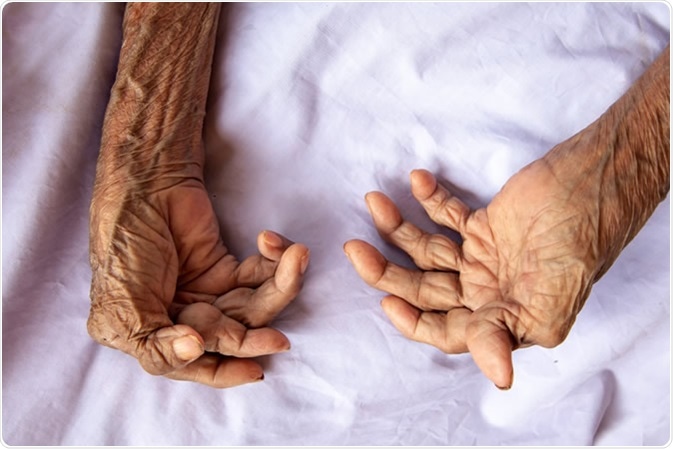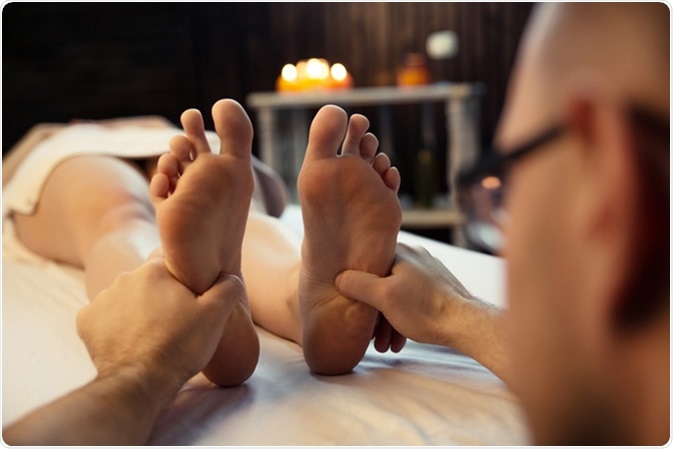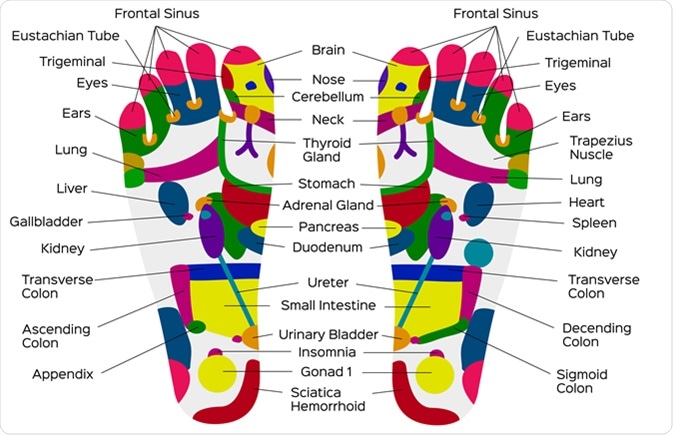
Does Reflexology and Massage Help with Arthritis?
Skip to:
Arthritis or joint inflammation is a symptom as well as a disease because it affects daily life activities so significantly. There are a number of conditions in which arthritis occurs, from osteoarthritis to rheumatoid arthritis, affecting a whopping 54 million Americans.

The hands of a woman with rheumatoid arthritis. Image Credit: Witsawat. S / Shutterstock
Osteoarthritis is a mainly degenerative condition of the joints, typically the weight-bearing or overused joints such as the knee or shoulder.
Other inflammatory conditions are often accompanied by arthritis such as rheumatoid, psoriatic, juvenile, and reactive arthritis, as well as ankylosing spondylitis.
The management of arthritis depends on the underlying cause as well as the health of the patient. Medications are often prescribed, such as anti-inflammatory and pain-relieving drugs. Non-steroidal anti-inflammatory drugs are commonly used but have significant cardiovascular risks over the long term.
Other medications include disease-modifying anti-rheumatic drugs such as methotrexate, or sulfasalazine, which are generally meant to suppress the hyperactive immune reaction that triggers arthritis in many autoimmune conditions.
Biologics are a third avenue of treatment, again targeting the immune system at a particular step rather than wholesale.
The significant side-effects associated with the use of many of these drugs have led to a never-ending search for less harsh treatments. Many of these are classified as ‘alternative’ or ‘complementary’ therapies, and their benefits, as well as risks, are mostly unproven by rigorous, scientifically designed trials. However, many of them are vouched for by patients who have found relief through their use. Two of them are reflexology and massage.
Reflexology
Reflexology is the term given to the application of varying degrees of pressure to specified areas on the feet, as a means of inducing relaxation and relieving stress. These are called reflex points, and each of them is said to associate with a structure or an organ in the body. The areas chosen are those which correspond to the painful areas of the body, according to reflexology theory.

Image Credit: Marina Eno / Shutterstock
Reflexologists believe that problems in the body are revealed in the corresponding area of the foot. These are depicted on a standard chart which is used to select the areas to which pressure is to be applied, using a specific method.

Foot reflexology chart. Image Credit: Gritsalak Karalak / Shutterstock
Typically, a reflexology session lasts an hour, during which a detailed history is first taken about lifestyle, past illnesses, and the current problem. After a careful foot examination, the whole foot is gently massaged first to relax it. Subsequently, the specific foot area is then treated.
Many chiropractors and physical therapists offer reflexological treatment. Most modern medical practitioners would recommend that this mode of treatment be taken alongside conventional treatment methods to complement them rather than replace them.
Evidence for reflexology
Several studies have suggested that patients experience pain relief, have less anxiety and lower stress levels, and improved sleep. There are no known adverse effects. A small trial in Turkey also found significantly less pain and better sleep in patients with rheumatoid arthritis after a six week trial of this technique.
Massage
Massage has been used for ages to relieve pain and swelling due to inflammation. It relies upon physically manipulating soft tissues, to encourage circulation, carry away inflammatory factors, and ease muscle spasm.
Many types of massage are known, including classical or Swedish massage, which is the most popular, as well as clinical massage, sports massage, and Eastern massage techniques.
Massage is a technique that involves both mind and body because it provides a sense of relaxation and comfort irrespective of the actual clinical outcome. Though it has been used automatically for ages to soothe injured parts of the body, in all cultures, very little modern research has been done on massage for osteoarthritis.
Evidence for massage
The few studies that have been carried out involve small numbers of patients, but there is some evidence that it does relieve the pain and stiffness, with better knee function, at least for a short time. Over the long term, however, the improvement flattens off, and further massage doesn’t seem to have any better results than with the usual care.
Serious side effects such as blood clots and are very rare, and mostly result from very vigorous massage, or occur in frail or elderly persons. In other words, massage in patients with arthritis should take into account the increased sensitivity and proneness to inflammation of these joints, compared to massage in healthy people.
Another study shows that the most significant benefit from massage for patients with knee osteoarthritis in terms of cost-effectiveness comes with a single massage for 60 minutes once a week over the affected joint. This study also confirms that the benefits decline over time to the point that patients without and with massage have similar improvements in pain and joint function outcomes with long-term follow-up, compared to their status at the start of the study. Thus, massage can help patients in the short-term but does not appear to be an effective long-term therapy.
The conclusion is, therefore, that these may well complement medical therapy for arthritis, with psychological and functional benefits at least over the short term. More research is required to clarify their duration of benefit and mode of action.
Sources
- Nih.gov. (2017). Reflexology. https://nccih.nih.gov/health/reflexology
- Nih.gov. (2019). Massage therapy: what you need to know. https://nccih.nih.gov/health/massage/massageintroduction.htm#hed1
- Bakir E. Baglama S. S., and Gursoy S. The effects of reflexology on pain and sleep deprivation in patients with rheumatoid arthritis: a randomized controlled trial. Complementary Therapies in Clinical Practice. 2018 May;31:315-319. doi: 10.1016/j.ctcp.2018.02.017. https://www.ncbi.nlm.nih.gov/pubmed/29705475
- Bauer, B. A. (2018). What is reflexology? Can it relieve stress? www.mayoclinic.org/.../faq-20058139
- Nih.gov. (2012) Study determines optimal dose of massage for osteoarthritis of the knee pain research. https://nccih.nih.gov/research/results/spotlight/020812.htm
- Betterhealth.vic.gov.au. (2015). Reflexology. www.betterhealth.vic.gov.au/health/ConditionsAndTreatments/reflexology
- Cdc.gov. (2018). Arthritis. https://www.cdc.gov/arthritis/data_statistics/national-statistics.html
Further Reading
Last Updated: Feb 17, 2020






















.png)









No hay comentarios:
Publicar un comentario